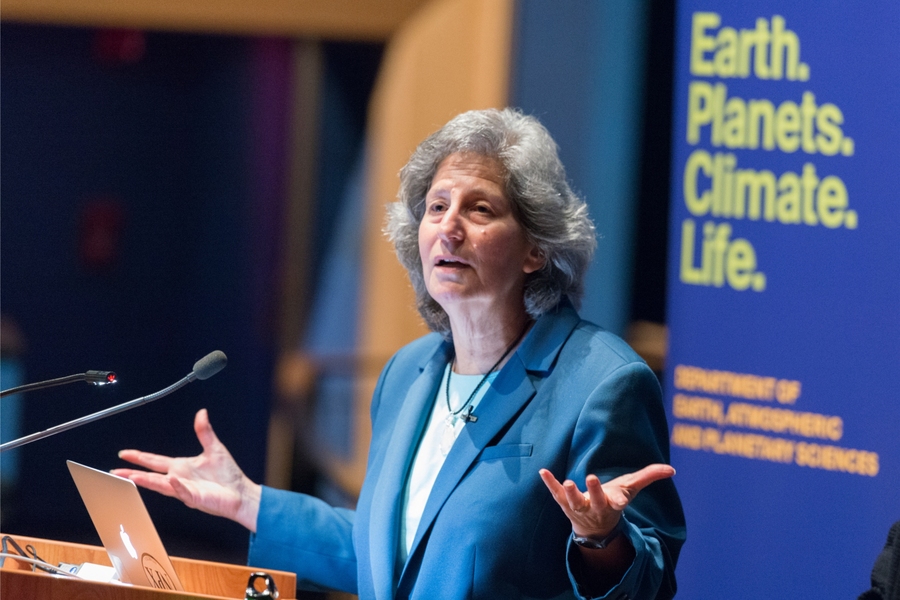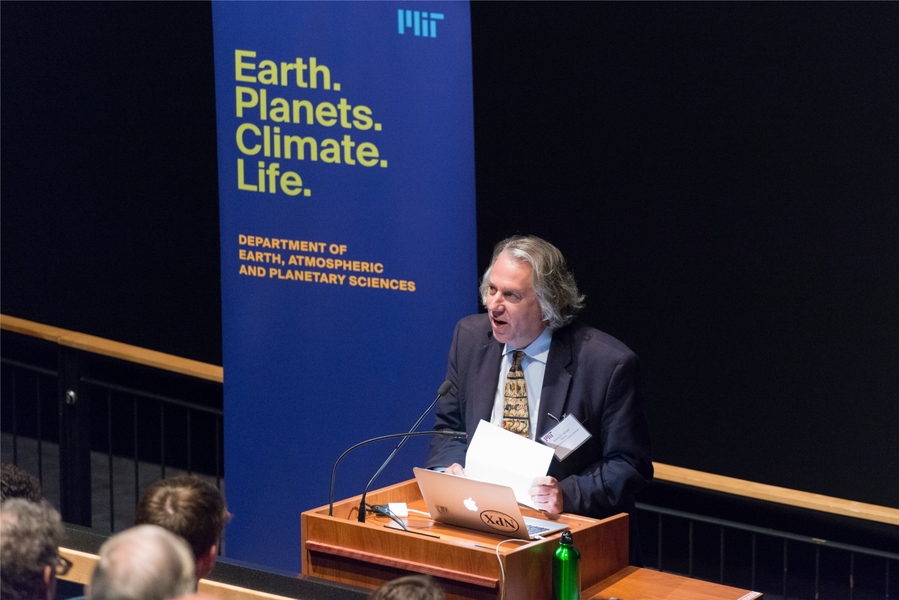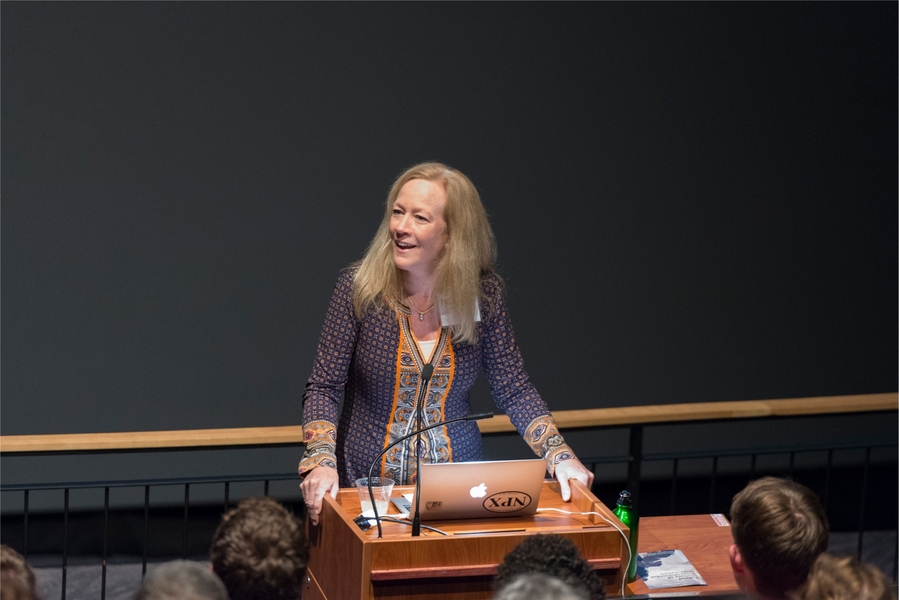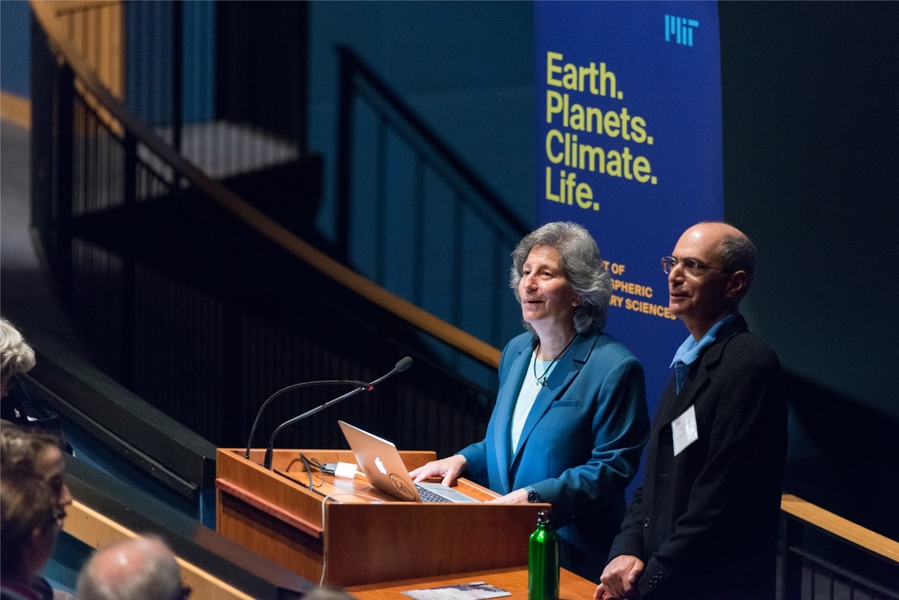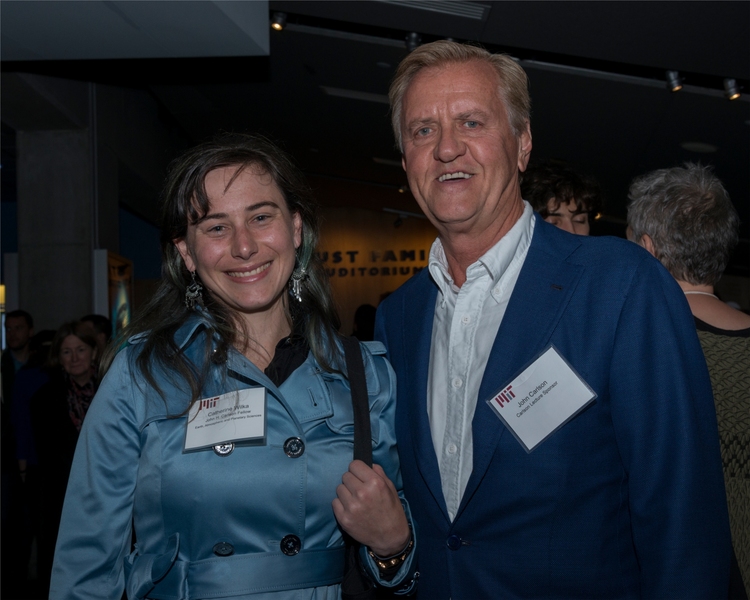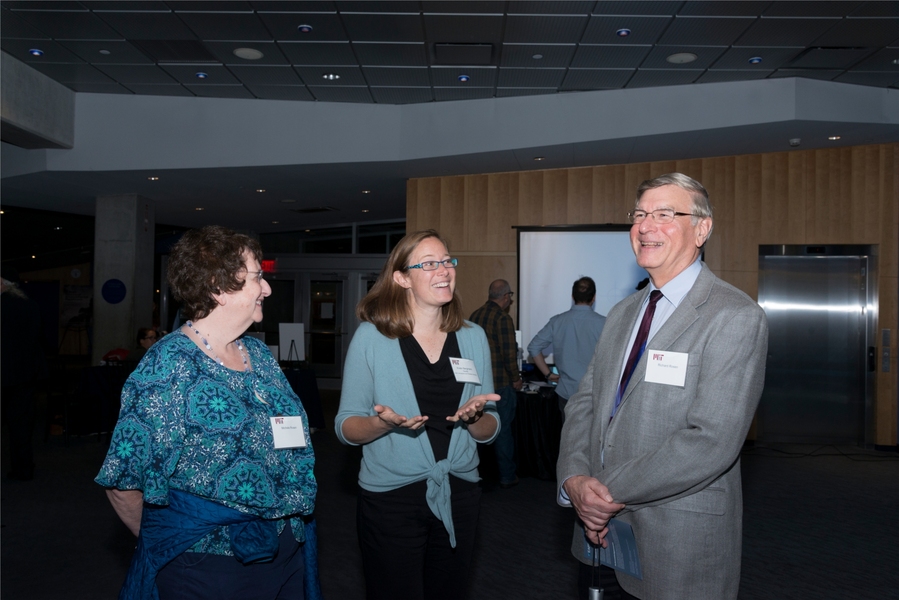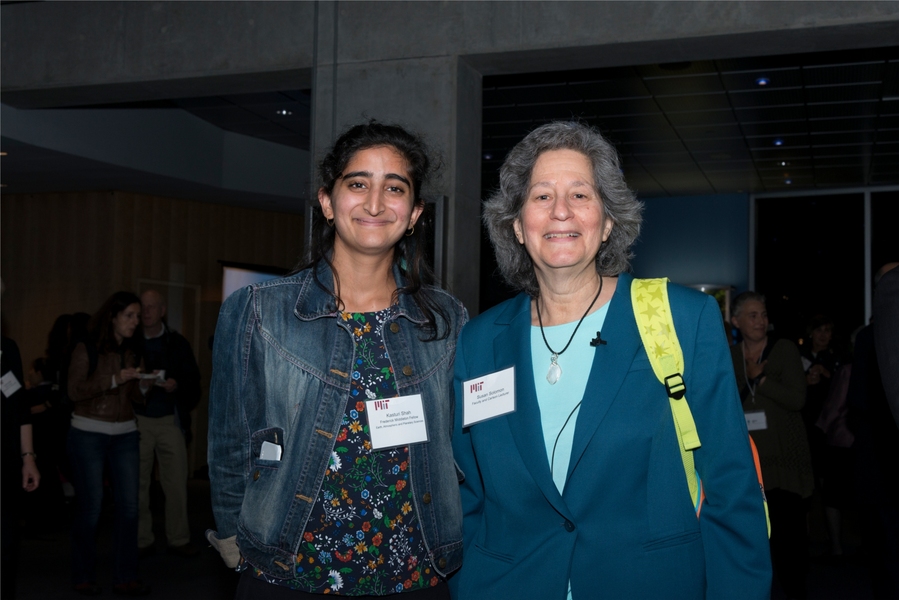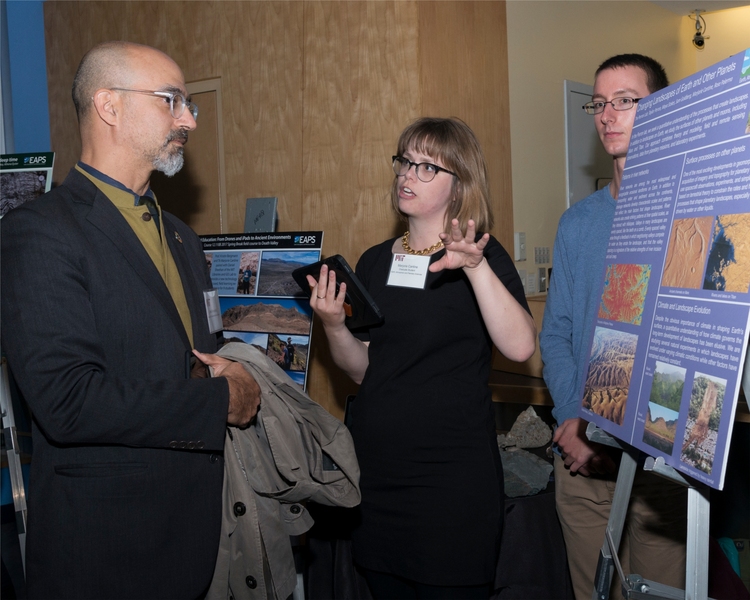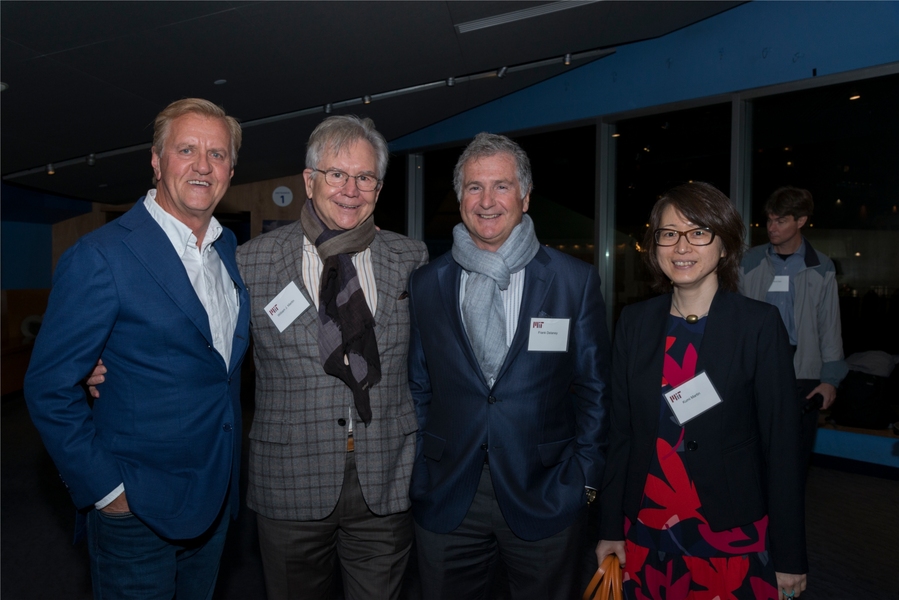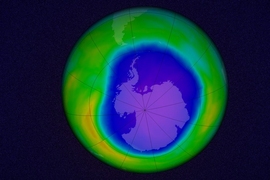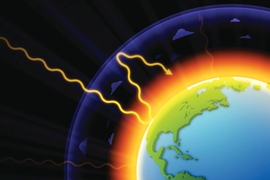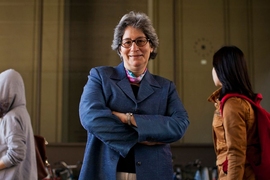The headlines are full of bad news about the environment, but Susan Solomon, the Lee and Geraldine Martin Professor of Environmental Studies at MIT, thinks it’s important to celebrate and learn from past successes as we think about today's environmental challenges.
"We don't have a perfect record, certainly, but we have done a lot of things remarkably well," Solomon said the beginning of her lecture at the New England Aquarium last month. "Lots of issues have been managed rather than solved, but our performance is still one to really celebrate and above all to learn from."
The Lorenz Center invited Solomon to give the 7th annual John H. Carlson Lecture to talk about past environmental challenges that were successfully overcome and how climate change, as perhaps “the mother” of all environmental challenges, compares. Solomon, who joined MIT in 2012 after 30 years as a scientist working at the National Oceanic and Atmospheric Administration (NOAA), began her career on research identifying the chemistry responsible for the ozone hole over Antarctica, work that laid the foundation for what became arguably the signature environmental success story of the 20th century.
As she recalled, in that case, even back when the predictions pointed to problems "far in the future" and while it was still just a hypothesis, "concerns over ozone depletion were taken seriously not only by scientists but also by the public. So why then should global warming, the defining environmental issue of our time, be any different?" Solomon sees three "Ps" generally involved in taking action to successfully combat an environmental problem: Is the issue perceptible? Is it personal? Are the solutions understood to be practical?
In the case of the Antarctic ozone hole, the data were clear. There was something a little bit exotic and compelling about Antarctica that Solomon credits with likely having raised public interest, but perhaps more importantly, the science story was an easy one to tell, with unequivocal data and satellite maps of the hole that were readily understood.
Ozone damage, because it impacts human health so directly, is a deeply personal issue. Without ozone to absorb damaging ultra violet light, people faced not only the increased risk of a faster sunburn, but the much more serious personal risk of developing skin cancer.
And then there were the plethora of practical solutions that were found, and which Solomon shared, from switching away from aerosol product delivery to replacing chlorofluorocarbons with their much less reactive hydrochlorofluorocarbon cousins in refrigeration and air conditioning.
Strongly linked to her three Ps, Solomon also emphasized the inevitable delicate accompanying "ballet" that has to play out between the public, the perception of the problem, the science, the politics, industry, and technology — each interacting in different ways depending on the issue.
In the case of stratospheric ozone, nations around the world got together in 1987 to adopt the Montreal Protocol with the goal of first freezing and then phasing out chlorofluorocarbon emissions. The result has been spectacular, enabling us to avoid a global ozone hole with all that would have meant. But as Solomon pointed out, the tide turned more than a decade earlier, not because of either regulation or theories explaining the hole, but in large part because many American consumers (Solomon referred to them as "we the people") turned "good business into bad business;" in other words, they were willing to go to their medicine cabinets and make the switch from spray deodorant to a roll-on one, which at the time put the U.S. response ahead of Europe’s.
Pivoting from the problem of "good" ozone in the stratosphere to the problem of "bad" ozone (the kind responsible for photochemical smog at ground level), Solomon then examined smog’s three Ps and the public, scientific, political, industrial, and technological ballet involved in that case. Smog was — and, as in Beijing today, is — clearly perceptible. You can see it. If you are in it, you can sometimes taste it. It also increases the incidence of asthma, and is particularly harmful to the developing lungs of small children making its effects, again, strongly personal.
As to practical solutions, Solomon said that in the U.S. once the science had been done to understand what was causing the problem, innovation exploded with tremendous advances such as in “positive crank case ventilation to keep the excess hydrocarbon from escaping out of your engine” and “catalytic converters to transform the effluents coming out of your tailpipe to things that would be unreactive and not make smog."
The Clean Air Act that resulted was passed by Congress in what today would perhaps be an unimaginable vote of 73 to 0. How did it attract such strong support? Public opinion and public engagement, said Solomon.
“It was personal, it was perceptible, but social movements are also incredibly important.” The first Earth Day in 1970 drew an estimated turn out of 20 million people nationwide. The counter culture, Rachel Carson’s book "Silent Spring" — all of these, Solomon said, spoke to and reinforced a prevailing sentiment of “Is this the way to live?” Quoting part of Richard Nixon’s 1970 State of the Union address, Solomon pointed to how public engagement had, unlikely as it might seem now, translated into a political response to drive change.
As Solomon noted, there was even an important co-benefit in the need to remove lead from gasoline to prevent damage to the catalytic converters that were needed to clean up car exhaust — an example of one environmental solution unintentionally creating another. A more recent example is taking place in China, a country already seeing a tremendous increase in electric car sales, where it was announced recently that one in five new cars sold would have to use an alternative fuel by 2025.
Having quickly walked the audience through the canonical evidence for global warming, Solomon finally turned her attention to an assessment of the state of its three Ps.
Solomon is confident the effects of global warming are becoming increasingly perceptible thanks in part to extensive and ever longer high quality global temperature records. However, for New Englanders living away from the coast it may not yet feel deeply personal.
Solomon sees several factors conspiring: Besides being a classic "future problem," perceptions of climate change depend highly on where you live. If you live on the coast your experience of sea level rise may be very personal but if you live in the West, your issue may be fires. The natural variability of the local climate is such that the trend in temperature and everything related to it may still not yet be immediately perceptible where you are.
In terms of practical solutions, global warming is also inexorably connected with a world economy built on the back of fossil fuels. It connects to installed infrastructure, both our own (like our beloved cars and our houses with planned lifetimes of 10 and 50 years, respectively), but also infrastructure in which industry has made massive investments.
“We have to be realistic about [industry seeking to recoup their investment],” she said. “Added to which it’s also a mineral rights issue. Companies owning rights to coal, gas, and oil necessarily want to realize that value.”
Solomon finished by touching on the moral and ethical dimension of the problem. Comparing per person emissions numbers across the globe, Solomon reminded her audience that “on average, if you take the 6.5 billion people that are now in the developing world, they emit about five times less fossil carbon per person than the other 1 billion in the developed world. What about their future? If they develop using fossil energy to fuel that development the same way we did, this planet’s going to get very, very hot indeed, as much as 10 degrees Fahrenheit hotter by 2100. So what about those people’s future? What’s fair?”
In the end, Solomon says she’s optimistic because of global increases in the amount of installed non-fossil power in the past few years, and increasing commitments to low-carbon or zero-emission vehicles by many countries.
Although the U.S. must decide what role we as a nation are going to play, Solomon notes other countries continue to move forward. “We’ll see what happens: This is a 100-year problem, it’s not a four-year problem,” she said. In closing Solomon reflected that global warming is by far the toughest thing we have ever faced but that she thinks it’s clear that the mix of science, public engagement, innovation, the ballet, her 3Ps, and wise weighing of social and ethical choices, are leading us to the means of managing our planet’s atmosphere.
Five teams from the MIT Department of Earth, Atmospheric and Planetary Sciences (EAPS) engaged the lecture audience in lively discussion with climate science displays during the pre-lecture reception in the IMAX foyer. Graduate students, postdocs, and researchers sharing their research included Grayce B. Kerr Fellow Tristan Abbott and Henri Drake, both from the Cronin Group; Marjorie Cantine and Julia Wilcots from the Bergmann Group; Gabi Serrato Marks, Norman C. Rasmussen Fellow Michaela Fendrock, and Chris Kinsley from the McGee Group; Ali Ramadhan from the Marshall Group; Warittha Panasawatong from the Wang Group; and Jon Lauderdale and David Talmy from the Follows Group. Faculty members co-presenting included Kristin Bergmann, Tim Cronin, Mick Follows, Lodo Illari, and David McGee.
Following the lecture, John Carlson welcomed EAPS alumni, friends, faculty, and students to a private dinner in the Harborview Cafe, with a special greeting for Nancy Lorenz, daughter of the late Professor Ed Lorenz. Carlson also thanked Solomon for her inspiring talk, and spoke about his seven years as a graduate student at MIT in meteorology. Department head Robert van der Hilst warmly thanked Carlson and those who have supported EAPS climate research, and encouraged others to consider supporting the Lorenz Center or an EAPS graduate fellow in climate science.
